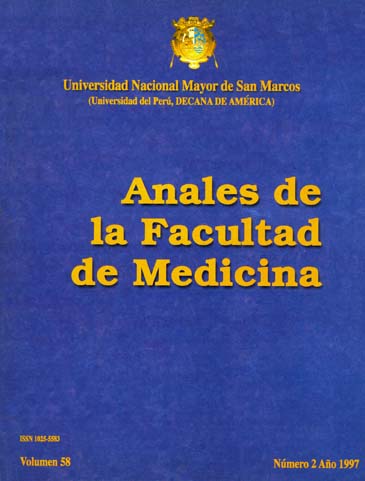Lower Insulinic Resistance on High Altitude Obese Inhabitants
DOI:
https://doi.org/10.15381/anales.v58i2.4697Keywords:
Obesity, Insulin resistance, High altitudeAbstract
It has been demonstrated that obesity produces insulin resistance, dislipidemia, high blood pressure and other metabolic alterations which are risk factors to develop atherosclerosis and cardiovascular events. On the other land, chronic expossure to high altitude increases the insulin sensibility; the blood glucose concentration, total and LDL cholesterol are lower in high altitude dwellers than in sea level inhabitants, and HDL cholesterol is higher. Therefore, it seemed interesting to study the metabolic events in the obese people living at high altitude. A total of 41 male obese, aged 20 to 60 years, were studied; 11 living at sea level (Lima, 150 m above sea level) and 30 living at high altitude (Huancayo 3200 m above sea level). Oral glucose tolerance tests consisting in 75 g were conducted in these subjects. Anthropometric measures (height, weight, body mass index, abdominal ship index) as well as blood glucose, total and HDL cholesterol, triglycerldes and insulin were measured. LDL and VLDL were calculated following the Friedewald's formula. Blood glucose, and insulin were significantly lower 2 hours after the glucose administration in the high altitude obese subjects demonstrating that obese subjects at high altitude have a lower insulin resistance, which is also supported by the higher HDL2 concentration, lower blood pressure and no hypertensive subjects. These results demonstrate that exposition to high altitude lowers the insulin resistance and the accompaning metabolic and clinical events even in obese subjects.Downloads
Published
1997-06-16
Issue
Section
Trabajos originales
License
Copyright (c) 1997 Nancy Jo, Fausto Garmendia, Gladys Damas, Rosa Pando, Sharon Saavedra

This work is licensed under a Creative Commons Attribution-NonCommercial-ShareAlike 4.0 International License.
Those authors who have publications with this magazine accept the following terms:
- Authors will retain their copyrights and guarantee the journal the right of first publication of their work, which will be simultaneously subject to Creative Commons Attribution License that allows third parties to share the work as long as its author and its first publication this magazine are indicated.
- Authors may adopt other non-exclusive licensing agreements for the distribution of the version of the published work (eg, deposit it in an institutional electronic file or publish it in a monographic volume) provided that the initial publication in this magazine is indicated.
- Authors are allowed and recommended to disseminate their work over the Internet (eg: in institutional telematic archives or on their website) before and during the submission process, which It can produce interesting exchanges and increase quotes from the published work. (See El efecto del acceso abierto ).
How to Cite
1.
Jo N, Garmendia F, Damas G, Pando R, Saavedra S. Lower Insulinic Resistance on High Altitude Obese Inhabitants. An Fac med [Internet]. 1997 Jun. 16 [cited 2025 Jun. 2];58(2):109-11. Available from: https://revistasinvestigacion.unmsm.edu.pe/index.php/anales/article/view/4697



